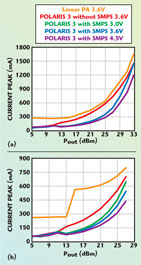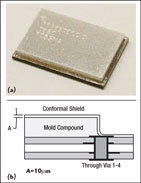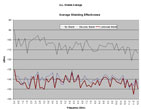 As cell phone manufacturers add more features to their products, there is less space for the cellular radio.
As cell phone manufacturers add more features to their products, there is less space for the cellular radio.
What was the board area allocation for the cellular radio several years ago now must also include Wi-Fi, Bluetooth® and GPS radios. In addition, there is now the added complication associated with EMI and RFI issues of collocated radios. The RFMD POLARIS™ 3 TOTAL RADIO™ incorporates key innovative module packaging technologies and power savings circuit architectures that address EMI and RFI challenges while providing handset manufacturers a very compact power efficient radio solution, enabling shortened time to market and low cost of ownership.
POLARIS™ 3 follows up the industry leading POLARIS™ 2 TOTAL RADIO Solution for E-GPRS applications with a smaller, more advanced DigRF compliant EDGE radio. The solution consists of the RF6030, a transceiver module containing a single chip RF CMOS transceiver and RX SAW filters: the RF3251, a self RF shielded transmit power amplifiers (PA) with front-end switch module, and the groundbreaking RF9003 DC-DC Switch Mode Power Supply (SMPS). At less than 200 mm2 footprint for the entire radio (270 mm2 with the SMPS), POLARIS 3 is one of the smallest, most efficient and advanced quad-band EDGE radio solutions offered. Some of the POLARIS™ 3 features include:
• Robust 3rd Generation Large Signal Polar Modulation EGPRS Radio
- Two-module radio with very few external components—eases layout
• Fast Calibration
- Less than seven seconds for TX path (inclusive for four bands, both GMSK/ EDGE, all PCLs)
- Validated in factory environment
- Patent-pending Auto RX image reject calibration circuits eliminates factory calibration
• Small Board Area < 200 mm2
- Greater than 40 percent board area reduction over the previous radio generation
• Self-shielded TxM
- Patent-pending self-shield eliminates the need for external shield and speeds up development time
• Lower Power Consumption
- Open Loop Large Signal Polar Modulation for maximum transmit efficiency
- Additional 30 percent or more improvement when used with optional RF9003 SMPS
• Adaptive Power Control Feedback
- Addresses Total Radiated Power (TRP) and SAR challenge
- Reduces output power and current variation into changing antenna load
• True Digital AFC
- Supports free running, low tolerance crystal
- Shortens factory calibration time
• DigRF 2.5 Compliant Interface
- Compatible with many cellular base bands

The radio solution is quite compact. Figure 1 shows there are very few external components, most of which are just decoupling capacitors. The RF modules offer improved design cycle time since the RF interfaces are pre-matched and are less prone to parasitic board affects, thereby easing layout constraints. The self-shielded RF3251 TxM further reduces complications of coupling and detuning normally associated with external shields.
POLARIS 3 Open Loop Large Signal Polar Modulation Architecture
RFMD was one of the first semiconductor companies to commercialize open loop large signal polar modulation with the successful introduction of POLARIS 2. This modulation approach is fundamentally the most efficient architecture since the power amplifier is always in saturation. POLARIS 3 improves upon the architecture by incorporating features inherent to large signal polar modulation to dramatically improve both factory calibration time and talk time.
As in a linear system, the raw TX symbol data is mapped into I and Q vectors and then is finite impulse response (FIR) filtered. After this step the I and Q vectors are converted to amplitude and phase. The amplitude and phase signals are aligned so that they will arrive at the antenna at the same time.
The phase signal is corrected for power amplifier impairments and is then pre-distorted and applied to the modulation port of a translational loop fractional N synthesizer. The output of the fractional N synthesizer is directly at the desired RF frequency and is amplified by a nonlinear power amplifier.
The amplitude signal is multiplied by the power control ramping, corrected for various power amplifier imperfections, and then D/A converted and used to drive the PA output level. In the case of POLARIS 3 this is accomplished with a linear regulator driving the collector of the power amplifier with the regulated voltage set by the D/A output voltage. As an option, the RF9003 SMPS may be used to efficiently convert the battery voltage to the operating voltage of the PA in the RF3251.

The system shown in Figure 2 is mostly digital in implementation. The only non-digital areas are the filter of the D/A converter, the analog components of the fractional N synthesizer, the collector regulator and the power amplifier. Thus, much of the complex analog circuitry of the linear system has been replaced with inexpensive and easily integrated digital functionality.
In addition, the polar modulation system has lower current drain than the linear system. The IQ modulator is eliminated and the power amplifier can be run in a more efficient nonlinear mode.
Finally, the polar modulation system does not require any filtering between the VCO and the power amplifier. This is due to the low noise nature of the VCO output of the fractional N synthesizer.
This architecture lends itself to very fast and accurate TX calibration. Pre-distortion curves for both AM-AM and AM-PM are stored in RAM look up tables (LUT) on the RF6030 transceiver. The LUT curves along with an integrated TX calibration routine make it possible to dramatically improve TX calibration time.
The built in calibration routine allows the transmitter amplitude and phase signature to be directly measured speeding up the TX calibration.

Since the PA is always in saturation, both GMSK and 8PSK alignment information can be calculated from the same measurements, whereas other competing solutions such as Linear EDGE require separate measurements be taken in GMSK and 8PSK modes. Furthermore, POLARIS 3 is designed to use standard factory test equipment and requires no special data patterns to be generated. The chart shown in Figure 3 compares the calibration time against a typical linear EDGE solution and the earlier generation POLARIS 2 calibration time.
Real Power Savings
When it comes to talk time and power dissipation, the trend to smaller and thinner handsets and correspondingly smaller batteries have become a major challenge confronting the handset designer. The RF9003 SMPS offers designers the ability to increase talk time over 30 percent without the need to increase the battery size, while taking up only 70 mm2 of board area. This allows the handset designer to add functionality such as DVB-H TV for higher end smart phones with the existing battery size, or reduce the battery size and cost for very thin handsets.
As mentioned POLARIS 3 PA operates in saturation for both GMSK and EDGE modes. This fact makes it very easy to incorporate a SMPS for improved power savings.
The RF9003 is designed to efficiently convert the higher battery voltage (typically 4.5 fully charged) to the operating voltage the PA requires for the corresponding output power, typically 3.2 to 1 VDC.

The graphs in Figure 4 show the POLARIS 3 radio battery current consumption with and without the RF9003 SMPS. Also shown is typical improvement the POLARIS large signal polar modulation architecture offers over a traditional linear EDGE radio architecture.
As the graphs show, the battery current consumption improvement is considerable when the battery is fully charged at around 4.5 V. The current consumption gradually increases as the battery is discharged. The RF9003 will go into a bypass mode when the battery voltage is too low to provide any benefit the SMPS would add.
To date, it has not been practical to use a SMPS to supply bias to GMSK power amplifiers used in handsets. The RF9003 SMPS is the first commercial solution that is best-in-class in both size and low noise suitable for use in E-GPRS handsets.
The RF9003 SMPS had to overcome the hurdle of being fast with slew rates on the order of microseconds to track the GMSK timing mask while being quiet enough to meet the regulatory ETSI noise requirements in the TX and RX bands. Reducing the clock switching speed would reduce the noise but response time would be compromised and would also require large switching inductors.
Conversely, increasing the clock switching frequencies reduces the switching inductor and response time at the expense of more noise.

Instead, a novel clocking scheme is used to spread the clock noise over a wide enough bandwidth to meet the ETSI requirements. Figure 5 shows the dramatic improvement in noise and spurs the RF9003 offers over traditional SMPS solutions.
SELF-Shielding Eases Layout and Improves Factory Yields
Take apart any handset and chances are there will be multiple shields, sometimes referred to as cans on a board. Some manufacturers incorporate the shield in the plastics via a metallized coating. In either case, board area must be set aside for the shields.
The need for the cans is due to the fact that most RF modules and practically all MMICs are unshielded and need to be protected from external interference as well as suppress any stray signals they may generate.
RFMD uses the self-shielding approach to develop modules that are self-shielded. This new exciting patent-pending technology is used on the POLARIS 3 RF3251 transmit module.

The self-shielding is plated onto the existing module compound, as shown in Figure 6. The module laminate is designed to allow the conformal layer to connect to ground vias spaced along the periphery of the module laminate.
This self-shielding technology offers significant benefits over other shielding methods:
Simplified phone PCB design
• No interference from module to module
• No interference from antenna to module
• No retuning required due to shield effects
Elimination of external shields from phone board
• Saves cost
• Saves board area (20 to 30 percent)
• Reduces module height (1.2 mm including shield)
• Minimizes rework costs
• More consistent results for better factory yields
The shielding effectiveness is shown in Figure 7. As the data shows, the performance of the self-shield is as effective, if not more than, conventional metal shields.
As an RF solution provider, RFMD recognized that it had to continue to invest in advanced circuit architectures and packaging technologies that will enable phones to incorporate more features in a smaller footprint at competitive costs.

To address the handset manufacturers’ need for shortened time to market and lower cost of ownership, RFMD embarked on developing and/or incorporating several key technologies that include single chip RF CMOS transceivers, self-shielding and power management. POLARIS 3 is one of the first products to bear the fruit of the company’s investment to develop these technologies.
RFMD,
Greensboro, NC,
www.rfmd.com.
RS No. 303
